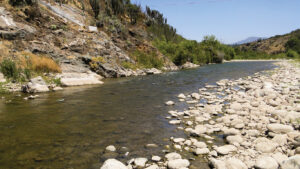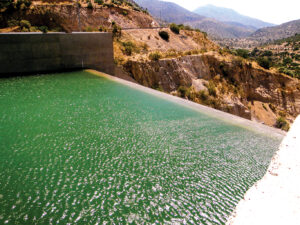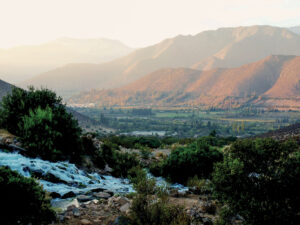T
he Choapa River and its Tributaries Joint Board of Control (Junta de Vigilancia del Río Choapa y sus Afluentes, JVRCH) provides water to 4,000 industrial and agricultural users in the Choapa River Valley of north-central Chile. Like most other regions of Chile, the Choapa River Valley is experiencing frequent, prolonged droughts. To face up to this challenge, the JVRCH is improving infrastructure and helping its users become more efficient.
In this interview, Ángela Rojas, the general manager of the JVRCH, speaks with Irrigation Leader Managing Editor Joshua Dill about the agency’s history and services and how it is facing up to water shortages.

Joshua Dill: Tell us about your background and how you came to be in your current position.
Ángela Rojas: I am an agricultural engineer by profession, and my career has unfolded principally in the area of irrigation and water resources management. I am a native of Salamanca, Chile, and for that reason I have always been interested in working in this valley. The opportunity to work for the JVRCH arose in 2010. My first function here was to design and implement a program to support farmers in modernizing the irrigation of their crops. In 2014, I assumed the managership of the JVRCH. In this position I, along with the work team, have implemented important technical modernizations that have improved the management of water and the efficiency of its distribution. For example, we have taken over the administration of the Corrales Reservoir, implemented automated gates, and provided legal and organizational support for our users.
Joshua Dill: Tell us about the JVRCH and its history.
Ángela Rojas: The JVRCH is a water users’ organization legally charged with the distribution of water from natural sources. It includes all the canals in its zone, which in turn are organized in water communities. In 1937, a prolonged drought made it necessary to organize the basin’s irrigators so as to distribute the scarce existing water supplies. The organization continued to operate de facto until its legal establishment in 1995. From that date until today, the JVRCH has worked to distribute the water in the basin and has assumed new duties aimed at making water use more efficient, made necessary by the continually growing demand for water and the falling level of rain- and snowfall each year. The JVRCH works to develop and implement projects oriented toward improving the storage, conveyance, and distribution of water and guaranteeing its quantity and quality.

Joshua Dill: How big is the JVRCH’s service area?
Ángela Rojas: Today, the JVRCH is composed of 98 water communities along the Choapa River, from the Andes mountain range to its outlet in the Pacific Ocean, delivering a total of 18,250 liters per second (approximately 644 cubic feet per second) of water. The JVRCH has around 4,000 water users, all of whom are equal before the law, independent of the use to which they put their usage rights, whether it be agricultural, industrial, or for consumption. Throughout the basin, agriculture coexists with mining, principally of copper. Agricultural users take more than 85 percent of the water. Among the most widely grown crops are pisco grapes, walnuts, avocados, and citrus fruits.
Joshua Dill: What are the JVRCH’s top current issues?
Ángela Rojas: Our principal and constant preoccupations are water shortage and the continuous periods of drought we experience. To face them, we have spent years working on projects and programs focused on the efficient and responsible use of water, aimed both at the improved management of water supplies and on the infrastructure necessary for the successful distribution and application of irrigation water.
Joshua Dill: What are the most important challenges for farmers in your region?
Ángela Rojas: The most important challenge they have to face is water shortage. Every year, they must make great efforts to continue production despite inclement weather, since droughts in our area are continually getting longer and more frequent. This is why, as a board of control, our top challenges include supporting the development of off-farm irrigation via the improvement of canals and supporting individual users in the development and execution of irrigation projects that will allow them to take advantage in a better way of the water they possess.

Another relevant challenge is our work on water storage facilities. We already have Corrales Reservoir, which has a capacity of 50 million cubic meters, ownership of which will soon pass from the national government to the JVRCH. In addition, we are working to turn our desire for a reservoir in the mountains at the head of our basin into a reality. We are beginning preliminary studies for that project.
Joshua Dill: How are irrigation projects in your region financed?
Ángela Rojas: Irrigation projects are financed principally by the national government through a variety of instruments, including competitions governed by Irrigation Law 18.450 for the promotion of private investment in irrigation, by means of which the national government finances up to 80 percent of canal improvement, technical modernization, and reservoir construction projects, among others. Large projects are financed through Law 1.123 for the execution of medium and large irrigation projects. This was the case with Corrales Reservoir, which was 79.99 percent financed by the national government.
Joshua Dill: What other entities does the JVRCH work with?
Ángela Rojas: The JVRCH works with agencies of the national governmental by taking part in competitions for the execution of projects and by applying for funds for the implementation of programs to strengthen our users. We work with the Ministry of Public Works, the Directorate General of Water, the Directorate of Hydraulic Works, the National Irrigation Commission, the Regional Corporation for Productive Development, and the Corporation for the Promotion of Production. In addition, we sign working agreements with private entities, including the Los Pelambres mine and the Los Pelambres Mining Foundation.

Joshua Dill: What is your vision for the future?
Ángela Rojas: Our vision is to become an consolidated and self-sustaining organization, to be autonomous, to have the community recognize us for management that is 100 percent oriented toward our users, to continue working constantly
on innovation and adaptation to new technologies, and to always be thinking about providing better service to irrigators in the basin and contributing toward the realization of an efficient and responsible use of our water resources.
Ángela Rojas is the manager of the Choapa River and its Tributaries Joint Board of Control. For more about the JVRCH,
visit www.jvriochoapa.cl/
